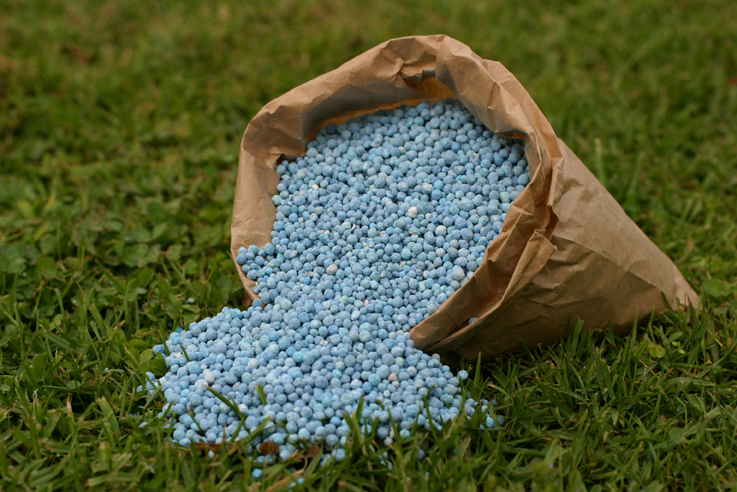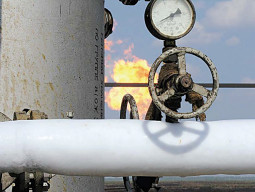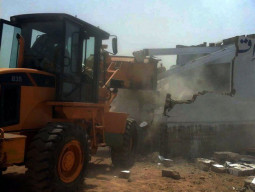
Sponsors of Fatima Fertilizer have mopped up tens of thousands of dollars from the open market in the last few weeks as part of their plan to invest in a fertiliser plant in the United States.
The move comes ahead of a shareholders’ meeting on April 30 to give the final nod for equity investment of up to $300 million in the Midwest Fertiliser Corporation (MFC) over a period of four years, which is building the fertiliser plant with a production capacity of 2.59 million tons a year in the US state of Indiana.
Fatima is the main sponsor for the project which is expected to start production in 2018. It is going to be the first nitrogenous fertiliser plant in the US in 20 years.
Foreign exchange dealers and banking industry sources say since State Bank of Pakistan (SBP) does not allow companies to remit money out of the country, the directors had to move the dollars from individual accounts.
“Fatima Fertilizer was very active last month,” said Malik Boston, chairman of Forex Association of Pakistan. “That is the reason the dollar shot up to Rs103 for a while.”
He said the pressure has now subsided. “We had informed the SBP governor about the unusual demand and that’s when we learned it was related to Fatima’s investment.”
The project, which will make Fatima the first Pakistani company to have a foothold in the US, remained in jeopardy for months after Indiana Governor Mike Pence pulled back key state support in February 2013, reason being that calcium ammonium nitrate (CAN) was being used for making improvised explosive devices across the border, according to US military officials in Afghanistan.
Fatima is the only company in Pakistan that makes calcium ammonium nitrate (CAN),
Since then, the company changed packaging and converted the colour of CAN grain to address US military concerns. But most importantly, it started work on a new chemical formula to make the fertiliser less explosive.
Fatima Fertilizer Chairman Arif Habib said the US meets half of its fertilser demand through imports. “We are building the project at the right time as it has coincided with all the shale gas discoveries.”
Gas or methane is key ingredient for making fertiliser and shale gas discoveries have brought down its price.
Habib said that the financing has been arranged in such a way that it will not put any burden on Pakistan’s foreign exchange reserves. Project management services contract has already been awarded to Jacobs Engineering Group and construction work is expected to start in November 2014.
Published in The Express Tribune, April 23rd, 2014.
Like Business on Facebook, follow @TribuneBiz on Twitter to stay informed and join in the conversation.
COMMENTS (22)
Comments are moderated and generally will be posted if they are on-topic and not abusive.
For more information, please see our Comments FAQ













































@Kashif: Sir, the farmer has paid all overhead increases of urea manufacturers due to gas curtailment and even much beyond that because 60 percent of the urea industry did not face gas curtailment and increased the prices parallel to the 40 percent suffering industry. It only happens in Pakistan on this globe.
As far as solution of fertilizer production is concerned significantly efficient products like Urea Superphosphate (USP), Urea Thiosulphate can be made from urea and about 15-20 percent of urea can be saved alongwith more efficient use of phosphorus and sulphur. Other benefits are better utilization of local rockphosphate reserves and 5-10 percent increase in crops’ yield. Some countries have been producing these fertilizers for the last 7-8 years or so. In addition very small investment is required for production of above fertilizers as compared a urea plant. Another advantage is the NPK produced by utilizing USP is more efficient and has less losses in the filed as compared to conventional NPK.
@Kashif: Sir, the farmer has paid all overhead increases of urea manufacturers due to gas curtailment and even much beyond that because 60 percent of the urea industry did not face gas curtailment and increased the prices parallel to the 40 percent suffering industry. It only happens in Pakistan on this globe.
As far as solution of fertilizer production is concerned significantly efficient products like Urea Superphosphate (USP), Urea Thiosulphate can be made from urea and about 15-20 percent of urea can be saved alongwith more efficient use of phosphorus and sulphur. Other benefits are better utilization of local rockphosphate reserves and 5-10 increase in crops' yield. Some countries have been producing these fertilizers for the last 7-8 years or so. In addition very small investment is required for production of above fertilizers as compared a urea plant. Another advantage is the NPK produced by utilizing USP is more efficient and has less losses in the filed as compared to conventional NPK.
@ Saleem ,
Where is solution of fertilizer production in Pakistan in your patriotic story. Again provide a solution, farmers don't love pakistan, they love the crop and the money coming in. All risk at their end. (Discuss on Fertilizer production) no stories.
@Kashif: Sir, when a "patriotic" industrialist i Pakistan purchases a public owned entity and pays five times less than the market value of that entity then there is no risk and when the public needs return for selling their industry so cheap the same industrialist is at high risk. It is really very good equation but for whom?
@ Saleem Mohsan,
Unfortunately stories don't work in industry or countries where investment risks are high. If you have any logic then reply. Your all comments don't carry any logic, raw material supply risk, investment risk .... please any logic i want to hear from you.
@Sahil Khan: Sir please visit the website of Fertilizers Department of India and learn about the TORs/conditions under which they have made joint ventures abroad.
@Kashif: Sir, there is an interesting short story. Somebody was going to die due to nonavailability of food. Luckily a person came and offered him to take rice, some fruits and drinks. But he declined his offer with the remarks that he likes bread only. The person repeatedly said to him that you may save your life by accepting his offer; there is variety of food, don't rely on bread solely but he insisted for bread and resultantly .....
This is very good. There are soo many companies from India, Africa, South East Asia which have increased international investment. A lot of the dividends come back to the home country, for investment there. It has been proved that the best top notch countries always venture globally. Fatima Fertilizer was a big investor, and will not close down here-- but its good. It puts Paksitan on the MAP. How many Pakistani companies are out there? Only Fatima now, Lucky Cement, an odd one here and there. Lucky Cement has two huge cement plants in Afghanistan, but will also start in Africa and Iraq. It is creating a global brand name.
We can never truly ever have Pakistani multinationals with this mindset.
And business' go where they get good tax incentives, and other facilities. Fatima Fertilizer is getting gas at very good and cheap rate. The supply will be continuous, and i believe they will probably have good tax incentives.
b
@ Samir, Brother I know these facts and agree with you. My focus of discussion is fertilizer production without raw material input.In 2050 and beyond Pakistan's problem will not be industrial production, it will be Food Security.
@ ibbi , Shale gas can be used in Canada and Japan for fertilizer production. You are right. In dear home land its not even viable to discover shale gas by E&P operators cost wise.
@ Saleem Mohsan, Fatima has many businesses i know, please focus discussion on fertilizer production, Thank you. Broader sense you cannot manage to discuss back.
@T: Profits from the investment do come back in Pakistan but to the investors only. Sir, there is another misfortune in Pakistan that we do not have courage to speak or listen the truth especially when it does not suit us.
@Kashif: Is Fatima Group owner of one business only? Can the dollars only be invested in a urea plant in US? Sir please look into the issue in a broader sense. I have many stories of fertilizer industry but this is not the moment to share.
@Kashif: Well brother the issue is Fatima Fertilizer gets gas in Pakistan at the cheapest rate in the world. Why does the rest of the industry in Pakistan have to pay rates ten times that of Fatima and Engro. We have been given this propaganda that gas is provided to these plants at cheaper rates so that they can produce cheap fertilizer for our poor farmers.
These are all lies, this is total crony capitalism. They get gas at ridiculously low rates and then sell fertilizer at international rates to our farmers. Khawaja Asif even raised this issue when he became minister, but I guess the Fertilizer producers know how to convince anyone at the helm of affairs in Pakistan. The bottom line is that gas should be sold at one price to all of industry, when you create multiple tarriffs, you open avenues for massive corruption which is true in this case.
@Kashif: But we can produce Fertilizer on Shalegas and Coal as well which we Have..... Anyway Goodluck to Fatima Fertilizers and Pray for the success of this Project to come online in 2018 Insha Allah. Afterall we are going have a company in Pakistan which is going to be Global. We hope to get dividents come back home after successful operation, so hopefully Investors will again in a position to re-invest in Pakistan. Have you read Arif Habib's statement in the Previous Interview with Express tribune: “We feel it’s a good investment opportunity. It is a profitable venture. And more than everything else it’s positive for Pakistan’s image.”
Keep it up. Brighter future is a head
@saleem wouldnt the profits from the investment come back to pakistan? The real dilemma for pakistan is the people who comment on things they dont fully understand :P
@ Saleem Mohsan,
No Gas no Fertilizer , No 101 ways. I am surprised at your wisdom.
There are 101 ways to return back through investment in the country. However, it needs true loyalty for the country which we generally lack individually as well as collectively.
@ Saleem Mohsan,
How to return back brother, when no natural gas supply and no iran piple line gas in near future. Fertilizer cannot be made by RFO or HFO.
This is real dilemma in this country. You earn a lot from here but do not like to return back something.
This is the real dilemma of Pakistan.
Please change picture as it is Engro plant not Fatima fertilizers.